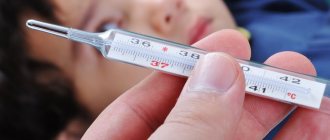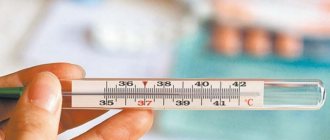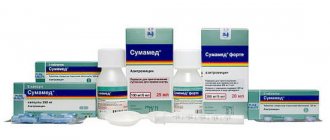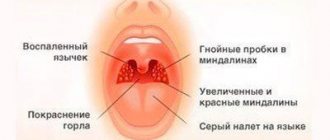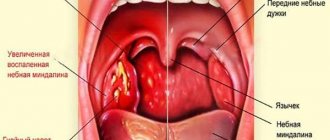What is the cause of high temperature?
The entry of a virus, bacteria, or allergen into the respiratory tract causes inflammation of the bronchiole mucosa. The presence of an inflammatory process in the bronchi leads to disruption of heat metabolism in the body. The immune system begins the fight for recovery. An increase in temperature indicates attempts by leukocytes to localize the lesion and prevent the disease from spreading to nearby organs.
This process involves the hypothalamus, one of the main parts of the brain. The immune system transmits data about the presence of inflammation along the nerve endings, the hypothalamus processes them and produces a reaction - increased or high body temperature. The more severe the disease, the higher the heat exchange. A blood test shows a significant increase in the number of leukocytes.
Hyperthermia: harm or benefit
The body's protective reaction to inflammation begins with an increase in heat exchange in all cells. There is an increased production of antibodies to destroy the pathogenic process. An increase in body temperature is necessary to eliminate the disease on its own.
Heat transfer, regulated by the brain, can be brought to the limit that the cardiovascular system can withstand. This limit is different for each person.
It is known that viruses die when the thermometer is high. Therefore, there is no need to worry if an adult’s body temperature rises to 38.5 °C. This is considered normal only if the thermometer scale remains at this mark for no more than 3-4 days. Fever that lasts longer than this period causes negative processes in the cardiovascular and nervous systems.
IMPORTANT! If signs of bronchitis with fever appear, you must remain in bed. Call a doctor at home. Don't pretend to be a hero! Funerals are expensive these days, and at work people will forget about you in three days!
Treatment of bronchitis with fever
When treating this disease, it is recommended to drink plenty of warm drinks, take antipyretics and vitamins. During therapy, bed rest must be observed. Then, when the temperature drops, you can use additional means: mustard plasters, special ointments. Inhalations help get rid of a painful cough. Baths with mustard, in which the feet are immersed, are considered an effective remedy.
In severe forms of the disease, antibiotics may be prescribed. For wet coughs, it is recommended to take mucolytics. For bronchitis in children, antitussive drugs should be prescribed by a doctor; self-medication is not recommended.
For example, children should not be given codeine-based products.
By suppressing cough, these drugs make it difficult to remove mucus from the bronchi. In addition, codeine can cause hallucinations, especially in children. Expectorants include herbal preparations based on plantain, elecampane, marshmallow, and thermopsis. They contain substances that enhance bronchial peristalsis. If a child has diseases of the nervous system, it is better to avoid them. The cough and gag reflex increases, which can lead to suffocation.
What is the temperature during bronchitis?
Chronic bronchitis is often accompanied by low-grade fever or its normal values. The absence of fever during various stages of the disease process indicates a person’s lack of immune defense. Against the background of a normal temperature reaction, cough, shortness of breath, and difficult sputum production are observed. In such cases, the bronchial inflammatory process is severe, with complications. Treatment takes a long time.
Low numbers on the thermometer scale (37.1–37.3 °C) are observed in the chronic form of the disease.
Acute inflammation of the bronchi makes itself felt by a sharp increase in heat transfer to 39.5 °C. Chills, severe weakness, cough, and wheezing worsen the patient’s already unimportant condition. An abrupt onset, absence of shortness of breath, and weak cough indicate a mild course of the disease: the elevated temperature reaction will last for several days and will subside.
In severe cases, if untreated, the mercury column of the thermometer can soar to 40–41 °C. This is a serious threat to the patient's life. With such numbers, protein coagulation in the blood occurs, the heart may not withstand the load, which can lead to death.
How many days does the temperature last?
The presence of fever during bronchitis indicates an attempt by the immune system to destroy the pathogenic focus in the body.
In the acute course of the disease, the temperature can last up to 3 days. Timely treatment helps to gradually reduce the numbers to normal levels, and the person’s condition returns to normal.
The length of the time interval during which the patient has an elevated temperature largely depends on the form of bronchitis, the severity of the inflammatory process, the presence of concomitant diseases, proper treatment, and the strength of the immune system.
In the absence of antibiotic treatment, the temperature reaction remains high for a week, and the patient's condition worsens. Bronchial inflammation can develop into pneumonia.
Adenoviral infection and bronchial inflammation
Regarding acute viral infections that develop with manifestations of bronchial damage, in this case the level of resistance of the patient’s immune system plays an important role in the occurrence of temperature. Characteristic symptoms of adenoviral infection are:
- lack of appetite;
- sneezing;
- temperature (37 ˚С);
- cough.
Unlike adults, bronchitis in children progresses very rapidly, and its course is more severe. Due to severe intoxication of the body, temperature changes are observed, as a result of which the disease is severe. In case of acute viral infection of the respiratory tract, complicated by inflammation of the bronchi and elevated temperature, the manifestations of infection are eliminated quite quickly.
With an adenovirus infection with the appearance of a cough, a tail of temperature is characteristic, occurring 7-10 days after the onset of the disease. And in children with convulsive seizures, a viral infection complicated by pneumonia, when the temperature rises to 38 degrees, is manifested by febrile convulsions.
In acute bronchitis, which lasts 3-4 weeks, or in case of relapse that occurs throughout the year, a chronic inflammatory process appears in the bronchi. The mucous membrane of the respiratory tubes and trachea secretes a lot of secretions, which impede the work of the epithelial cilia.
Inflammation affects the walls of the bronchi, as a result of which the connective tissue is destroyed. With each exacerbation of the disease, the patient's body temperature increases. So, in the morning it can reach 37 or 37.5 degrees.
If the patient's body is weakened, then inflammation is often accompanied by fever. This phenomenon occurs when bronchitis is accompanied by a bacterial infection that provokes an inflammatory process in the lungs.
With the constant production of sputum, which has a viscous consistency, the patient’s body weakens, and the temperature can be within 37-38 degrees. This condition is accompanied by:
- chills;
- malaise;
- aching joints;
- headache.
Why does bronchitis develop in young children? Bronchiolitis appears in a patient along with a viral infection, and the complexity of the disease is directly related to the level of the body’s immune system. Fever occurs 3 days after the onset of the viral infection. It is accompanied by symptoms such as:
- dry wheezing in the bronchi;
- cough;
- dyspnea.
In this case, the cough is spastic in nature, but the temperature can remain at 37˚C. Moreover, the severity of the symptoms in the sick person does not correspond to the presence of fever. However, the occurrence of primary symptoms of the disease is associated with cough.
But what exactly is the temperature for bronchitis in a child that requires quick medical attention? In this case, it is important to monitor the patient’s condition and measure the temperature every 3 hours.
If the patient's health rapidly deteriorates, a doctor should be called. After all, prompt medical assistance will prevent tissue dehydration and the development of oxygen deficiency.
Toxic bronchitis in young children develops without low-grade fever. This form of the disease can become chronic if left untreated.
How and with what to reduce the temperature?
At a temperature of 37.5 °C no medications need to be taken. Do not prevent the body from destroying harmful microorganisms. It is enough to stay in bed, put a cold compress on your forehead, and drink plenty of fluids.
If the thermometer shows numbers above 39 °C, measures must be taken:
- Call a doctor or contact him on Skype.
- Give the patient an antipyretic: tablet (ibuprofen, ibuclin, paracetamol), syrup (nurofen, panadol).
- Wipe the body of the patient with warm water and vinegar.
- Place a towel soaked in cold water on your forehead.
- If the patient is chilling, cover with a warm blanket.
At high temperatures there is a risk of dehydration. Therefore, try to give the patient more to drink (cranberry juice, tea with linden, raspberries, rosehip decoction, plain water).
IMPORTANT! At a persistently high temperature, if a person’s condition worsens, immediately go to the hospital and call a doctor.
Anal suppositories (cefecon, voltaren, indomethacin) are an effective antipyretic agent. Their introduction is simple and does not require much effort. Placed in the anus as deeply as possible. The action comes almost immediately. The effect lasts up to 7 hours from the moment of administration.
How to properly reduce temperature
There is no point in trying to bring down any temperature, since up to 38.5 degrees the body needs it to independently fight the disease. If the values on the thermometer exceed the specified threshold, the child may develop convulsions and even loss of consciousness. If a child has a high temperature, parents should follow these recommendations:
- Be sensitive to any changes in the child’s condition. To do this, it is worth measuring the temperature every 2-3 hours. If it rises sharply and your health worsens, then you need to consult a doctor.
- If the child tolerates the heat normally and the temperature does not exceed 38.5 degrees, then it is not recommended to bring it down.
- When the baby is really unwell, he is irritable and experiences severe discomfort, then it is worth giving an antipyretic. Many of these drugs are prohibited for children. Paracetamol for children is considered one of the safest. This drug is popular in the form of rectal suppositories - they are allowed for children under 2 years of age. Older children can be given mixtures or syrups.
Parents of infants should not wait for a strong rise in temperature - it is better to immediately call a doctor at home. The following procedures should not be carried out in the heat against the background of bronchitis:
- apply compresses and mustard plasters;
- rub with ointments with essential oils;
- do inhalations with hot steam, baths;
- use any cough medicines, including syrups and chest preparations, without a doctor’s prescription.
- How to reduce your appetite
- Cucumber salads for the winter - you'll lick your fingers, Winter King without sterilization
- Fungus between the toes: effective treatments
Medicines
For bronchitis, etiotropic and symptomatic therapy is carried out. The first is aimed at eliminating the cause of the disease. Depending on it, the doctor prescribes drugs from one of 3 groups:
- Antiviral: Grippferon, Arbidol, Anaferon. Used when the body is affected by viruses.
- Antibiotics: Suprax, Sumamed, Azithromycin, Zinnat. Indicated for bacterial bronchitis. This is indicated by yellow-green sputum.
- Antihistamines: Zyrtec, Erius, Claritin. Prescribed for allergic nature of the disease.
All other medications are prescribed by the doctor to eliminate the symptoms of the disease. The first group is expectorants. They should not be given to children under 2 years of age as their coughing fits will be worse. This can cause liquefied mucus to enter the lungs. At older ages, the following cough remedies are used:
- Expectorants: Pertusin, licorice root extract.
- Sputum thinners: Libexin, Bromhexine, Lazolvan, Acetylcysteine.
The advantage of the latter drug is that it is approved from birth. The daily dosage of Acetidcysteine for children under 2 years old is 200 mg in 2 doses, 2–6 years old – 100 mg 3 times or 200 mg 2 times, 6–14 years old – 200 mg 2 times. The product is used in the form of a water-soluble granulate. To do this, the contents of the bag are dissolved in 0.5 tbsp. water. After administration, fever, nausea, heartburn, stomatitis, and urticaria may occur. Acetylcysteine contraindications:
- hemoptysis;
- pulmonary hemorrhage;
- stomach or duodenal ulcer.
The last group of drugs used are antipyretics. Sometimes Ibuprofen or its analogue Nurofen is used (it is less safe, but more effective). For children over 1 year old, Analgin suppositories can be used. Doctors advise using this drug in rare cases when safer means are not available. Paracetamol is considered the safest. It is available in suppository and syrup form under a variety of trade names, including:
- Panadol;
- Calpol;
- Efferalgan;
- Meksalen;
- Tylenol.
Paracetamol suppositories may contain 0.125–1 g of active ingredient. They are allowed for children from 3 months of age. Daily dosage schedule for suppositories:
- for ages 3–6 months – 1 piece, 0.08 g each;
- children 1–6 years old – 1 suppository 0.17 g;
- child 7–12 years old – 1 suppository 0.33 g;
- over 12 years old – 1-2 suppositories 0.33 g.
The advantage of suppositories is that they act faster than tablets. The reason is that the active component from the suppository enters the bloodstream bypassing the stomach. This also helps reduce the number of side effects. Of these, the development of allergies and increased bleeding are noted. Contraindications for Paracetamol suppositories:
- diseases of the blood, liver and kidneys;
- stomach or duodenal ulcer;
- bronchial asthma;
- hemorrhagic syndrome;
- decreased blood clotting.
Non-drug remedies
If there is a fever, the child should stay in bed. This regime is observed at least until the intense fever disappears. He should often be given warm tea, compote, and fruit drinks. Compared to the usual drinking regime, the volume of liquid should be increased by 1.5 times. This helps thin mucus and remove it from the lungs. It is useful to give your child alkaline mineral water, mint and linden teas, cranberry juice, infusions of elderberry, blackberry, and raspberry. Decoctions of herbs, such as sage, have expectorant properties. Other recommendations for alternative treatment of bronchitis:
- To improve mucus discharge, it is recommended to perform a drainage massage. To do this, the child is placed on his stomach and gently tapped on his back with the edge of his palm. At the age of six months, simple patting with your fingertips will suffice.
- Over the age of 2 years, it is allowed to give a decoction of pearl barley. To do this, boil 200 g of cereal for 5 minutes in 1 liter of water. At the end, filter the broth and add a teaspoon of honey to it.
- To reduce heat, it is useful to wipe the body with a soft cloth using warm water or a solution with vinegar added.
What to do if the temperature does not subside?
You should be wary if a febrile state does not go away within several days - this indicates that the immune system cannot cope with inflammation, the disease has become complicated, and antipyretic drugs are ineffective. The patient may experience seizures, confusion, or cardiac arrest.
In this case, hospitalization and intramuscular injections of drugs that can reduce critical temperature values are necessary. Injections and IVs will help stabilize the patient's condition.
For intramuscular administration, methindol, spazgan, and pirokam are used. Saline solution with vitamin C, glucose, and hormonal agents (dexamethasone) are prescribed intravenously.
It is necessary to give the patient plenty of fluids. This helps remove toxins from the body and maintain water balance.


